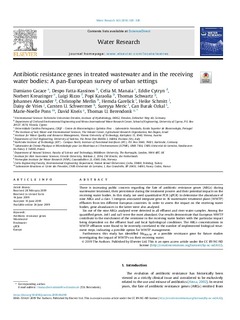| dc.contributor.author | Cacace, Damiano | |
| dc.contributor.author | Fatta-Kassinos, Despo | |
| dc.contributor.author | Manaia, Celia M. | |
| dc.contributor.author | Cytryn, Eddie | |
| dc.contributor.author | Kreuzinger, Norbert | |
| dc.contributor.author | Rizzo, Luigi | |
| dc.contributor.author | Karaolia, Popi | |
| dc.contributor.author | Schwartz, Thomas | |
| dc.contributor.author | Alexander, Johannes | |
| dc.contributor.author | Merlin, Christophe | |
| dc.contributor.author | Garelick, Hemda | |
| dc.contributor.author | Schmitt, Heike | |
| dc.contributor.author | de Vries, Daisy | |
| dc.contributor.author | Schwermer, Carsten Ulrich | |
| dc.contributor.author | Meric, Sureyya | |
| dc.contributor.author | Ozkal, Can Burak | |
| dc.contributor.author | Pons, Marie-Noëlle | |
| dc.contributor.author | Kneis, David | |
| dc.contributor.author | Berendonk, Thomas U. | |
| dc.date.accessioned | 2019-10-08T07:59:00Z | |
| dc.date.available | 2019-10-08T07:59:00Z | |
| dc.date.created | 2019-06-27T13:48:14Z | |
| dc.date.issued | 2019 | |
| dc.identifier.citation | Water Research. 2019, 162, 320-330. | nb_NO |
| dc.identifier.issn | 0043-1354 | |
| dc.identifier.uri | http://hdl.handle.net/11250/2620759 | |
| dc.description.abstract | There is increasing public concern regarding the fate of antibiotic resistance genes (ARGs) during wastewater treatment, their persistence during the treatment process and their potential impacts on the receiving water bodies. In this study, we used quantitative PCR (qPCR) to determine the abundance of nine ARGs and a class 1 integron associated integrase gene in 16 wastewater treatment plant (WWTP) effluents from ten different European countries. In order to assess the impact on the receiving water bodies, gene abundances in the latter were also analysed. Six out of the nine ARGs analysed were detected in all effluent and river water samples. Among the quantified genes, intI1 and sul1 were the most abundant. Our results demonstrate that European WWTP contribute to the enrichment of the resistome in the receiving water bodies with the particular impact being dependent on the effluent load and local hydrological conditions. The ARGs concentrations in WWTP effluents were found to be inversely correlated to the number of implemented biological treatment steps, indicating a possible option for WWTP management. Furthermore, this study has identified blaOXA-58 as a possible resistance gene for future studies investigating the impact of WWTPs on their receiving water. | nb_NO |
| dc.language.iso | eng | nb_NO |
| dc.publisher | Elsevier | nb_NO |
| dc.relation.uri | https://www.sciencedirect.com/science/article/pii/S0043135419305524?fbclid=IwAR0aBfJ3OSBC85kLbtUN16rCtj_OO_QTjHVtYJS1EPPWwZEQAuLDOnmTsNw | |
| dc.rights | Attribution-NonCommercial-NoDerivatives 4.0 Internasjonal | * |
| dc.rights.uri | http://creativecommons.org/licenses/by-nc-nd/4.0/deed.no | * |
| dc.title | Antibiotic resistance genes in treated wastewater and in the receiving water bodies: A pan-European survey of urban settings | nb_NO |
| dc.type | Journal article | nb_NO |
| dc.type | Peer reviewed | nb_NO |
| dc.description.version | publishedVersion | nb_NO |
| dc.rights.holder | © 2019 The Authors | nb_NO |
| dc.source.pagenumber | 320-330 | nb_NO |
| dc.source.volume | 162 | nb_NO |
| dc.source.journal | Water Research | nb_NO |
| dc.identifier.doi | 10.1016/j.watres.2019.06.039 | |
| dc.identifier.cristin | 1708326 | |
| dc.relation.project | Norges forskningsråd: 208430 | nb_NO |
| cristin.unitcode | 7464,20,16,0 | |
| cristin.unitname | Systemer og teknologi | |
| cristin.ispublished | true | |
| cristin.fulltext | original | |
| cristin.qualitycode | 2 | |

